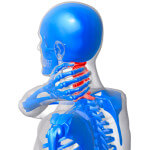 These days, many people dismiss the significance of whiplash and Whiplash-associated
disorders (WADs) because of the dramatic improvements in car design and
safety features implemented to prevent the neck snap injuries such as
whiplash, but whiplash still results from car crashes and the impact of
this injury may be severe and long-term.
These days, many people dismiss the significance of whiplash and Whiplash-associated
disorders (WADs) because of the dramatic improvements in car design and
safety features implemented to prevent the neck snap injuries such as
whiplash, but whiplash still results from car crashes and the impact of
this injury may be severe and long-term.
Whiplash is a broad classification of injuries to the soft tissue of the neck caused by a rapid acceleration and forward extension of the head and neck, followed immediately by a backward return. The violent motion causes an over-extension of ligaments and muscles beyond normal limits. This type of injury often can be the consequence of rear-impact collisions, but also may be caused by roller coasters or other amusement park rides, falls, sports injuries, or physical altercations. Symptoms of whiplash include severe pain and tenderness in the back and neck, muscle spasms, headaches, jaw pain, and nausea. In many cases, the pain fades and disappears over the course of a few weeks, but with more severe injuries, the pain can last long-term and be indicative of a more severe condition, whiplash-associated disorder.
When a person suffers from WAD, he or she experiences the typical pain associated with whiplash, as well as non-physical symptoms such as:
- Insomnia;
- Depression;
- Stress;
- Anxiety;
- Drug Abuse; and
- Post-Traumatic Stress Disorder.
WADs are classified as such because of the neurological component that is a part of the disorder. The severity of the condition has been broken into five categories by a specially-formed commission out of Quebec, Canada. The Quebec Task Force has delineated the classification as follows:
- Grade 0 - the patient exhibits negligible pain in the neck. This type of patient rarely seeks any type of medical treatment, so it is more of a point on the scale rather than a statistically significant group of sufferers.
- Grade 1 - the patient reports pain or soreness in the neck or back, but no evidence of the injury is identified by a treating physician.
- Grade 2 - the patient reports pain or soreness in the neck or back and his or her treating physician notes point tenderness, muscle spasms, and/or a decreased range of motion.
- Grade 3 - the patient exhibits pronounced decrease in range of motion, lacks reflexes present in uninjured individuals, and also reports one or more neurological symptoms.
- Grade 4 - the patient reports neck or upper back pain and there is an observable injury to the spinal cord, including fracture or dislocation.
Studies have been done on the speed of the vehicle that impacts another vehicle from the rear, the speed of the impacted vehicle, and the change in acceleration of the car being hit. Frequently, these accidents involved one vehicle that was at a full stop when it was impacted. The following observations relate to impact speed and severity of the resulting injuries:
- A patient suffers from the symptoms of WAD for a longer period of time when the impact occurs at a greater rate of speed.
- A patient will exhibit more severe injuries on the scale created by the Quebec Task Force as the speed of impact increases.
- Female patients exhibit more symptoms of WAD than men when involved in similar types of accident, with equivalent impact force and speed.
Car accidents are traumatic even when there is little or no physical trauma. Having to deal with the pain of whiplash and the neurological symptoms of WAD can be completely overwhelming. Let the experienced Lexington Kentucky personal injury attorneys at Goeing Goeing and McQuinn PLLC help you get the treatment and compensation that you need to reclaim your life. Please call us to schedule your free consultation.
